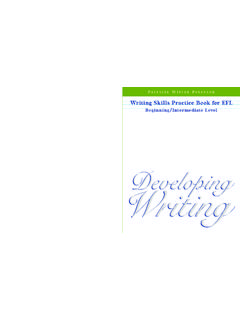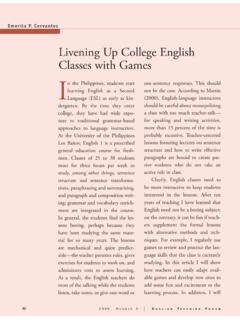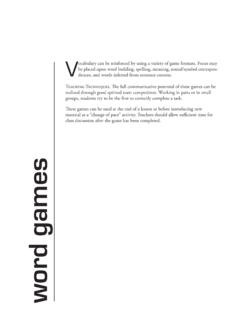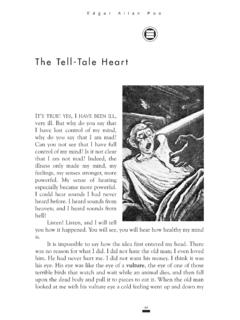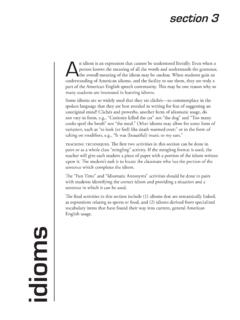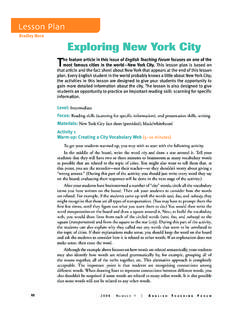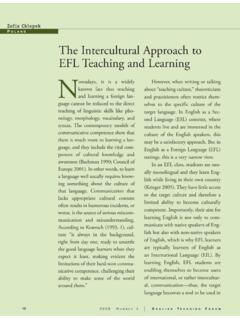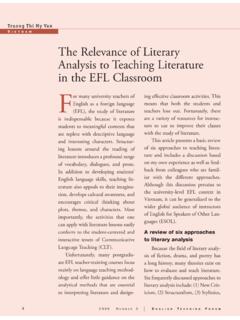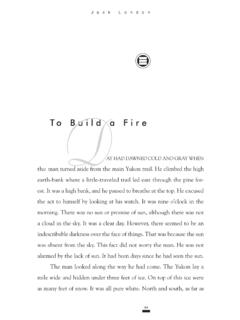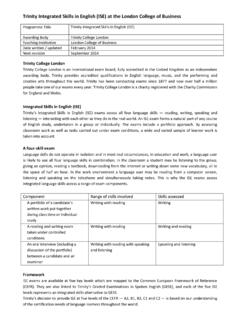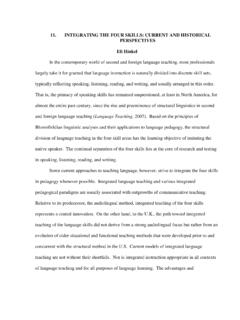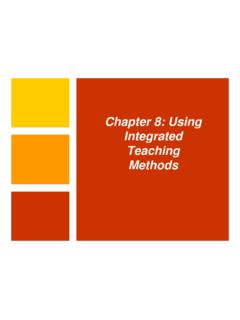Transcription of ”Maps and Legends“ by Michael Chabon - American English
1 40 APRIL2004 ENGLISHTEACHINGFORUMCARMELUNDERWOOD ANDROBERTUNDERWOODAn integrated skills Lesson Plan for maps and legends by Michael ChabonIn maps and legends , author Michael Chabon reflects ongrowing up in Columbia, Maryland, one of America s complete-ly planned cities. He writes about how he felt as a youth moving tothis city that was still in the early stages of construction. He describeshis childhood thoughts and dreams, and the discoveries he madegrowing up there. And throughout the essay, he reflects on how theexperience changed him and helped him become the writer he istoday. Chabon s essay and the following lesson plan guide studentsto reflect on and examine important moments in their own livesthrough the use of the English :This lesson plan is designed for EFL instructors who teach high inter-mediate to advanced English language learners. It is based on an authen-tic, contemporary essay, maps and legends by Michael Chabon , anaccomplished American novelist and short story writer.
2 The lesson planincludes various tasks and activities designed to assist you, the instructor,in developing your students English language skills as well as increasingtheir understanding of American culture. Students will study Chabon sessay, complete tasks both individually and in pairs or groups, and par-ticipate in activities that develop listening, speaking, reading, and writ-ing lesson is divided into five steps: Preparing to Read, Read-ing the Text, Understanding the Text, Making Connections Beyond theText, and Integrating Language can choose the parts of the lesson that you find most appropriateand useful for your class. Approximate times for each part of the lessonare included, but these times may vary, depending on the individualclass or teaching 1: Preparing to Read maps and legends (15 minutes)In order to prepare your students to read Chabon s essay, follow the suggestedsteps Through oral discussion, introduce the subject of the essay: Neigh-borhoods we lived in as your students about the neighborhood you grew up in, its location andappearance, the people who lived there, the other children you played withand the games you played together, a favorite place you frequented, a mem-orable event that took place there, etc.
3 Encourage them to ask you ques-tions about your ETF_34_56 4/14/04 8:50 AM Page your students to think about the neighborhoods they grew up in. Thenelicit their responses to the following questions. You may ask your studentsthese questions directly, or have students ask each other in pairs or did your neighborhood look like? Did it have a name? lived there? Did you have close family members nearby? Whowere your friends?c. What kinds of activities did you do with your friends and family? was special about your neighborhood? any memorable event occur while you were living there? If so, tell about the event and explain why it was memorable to Introduce the LessonExplain to your students that they will be reading an essay called Maps andLegends by Michael Chabon , a popular American writer who has writtenabout how growing up in his neighborhood in Columbia, Maryland, influ-enced him to become a writer.
4 Assure them that if they do not fully under-stand this essay on the first reading, after reading it a second and possibly thirdtime and analyzing the author s ideas carefully, they will gain a better under-standing of the writer s message as well as experience many opportunities tocommunicate in English and improve their language 2: Reading the Text(15 30 minutes depending on students abilities)Give your students photocopies of the essay (and Glossary) from this issue ofthe can also have students access the essay online at: Note: the online version does not have thenumbered paragraphs and Glossary mentioned in some exercises Review the during-reading tasks below with your students. Then askthem to complete the tasks as they read the essay unfamiliar words or ideas they do not notes in the margins about sections of the essay they would like to discuss or ask Ask your students to read the definitions of their circled words in theGlossar y provided or to look up the unfamiliar words in a dictionar they have access to the Internet, students can use one of the fol-lowing on-line dictionar y sites.
5 The American Heritage Dictionary of the English Language: Merriam-Webster On-line The Language Center: Ask your students to carefully read the essay a second time for ETF_34_56 4/14/04 8:50 AM Page 4142 APRIL2004 ENGLISHTEACHINGFORUMStep 3: Understanding the TextYou may assign the following questions for class or group discussion, asjournal or essay topics to be written in class, or for homework. To prepareyour students for oral discussion, follow the steps listed your students into pairs or groups of three to four each pair or group to choose one student to read the ques-tions each pair or group to choose one student to record the Ask each group to choose other members to present the answers to the your students a fixed time period to discuss the questions and com-plete the tasks in Step 3 before presenting their responses to the on each group to present their responses to the Comprehension Questions (15 20 minutes) did Michael Chabon s parents buy a new home in 1969?
6 Is James Rouse? was the Plan, described in paragraph 5, displayed? does Chabon see in the slide show that he describes in paragraph 6? paragraph 10, find the name of the neighborhood Chabon s familymoved does the author say he put the map of Columbia? paragraph 13, Chabon states that some critics believe the grand experi-ment of Columbia had failed. What reasons are given for this failure? does Chabon say about childhood in the last paragraph of the essay?B. Vocabular y and Idioms (15 minutes)Explain to your students that scanning is a reading skill that is useful for quick-ly finding specific information such as new vocabulary words or idiomatic ex-pressions. To scan, students should read through a text quickly as they searchfor specific words, expressions, names, or that guessing the meaning of unfamiliar vocabulary words andexpressions using the surrounding context is an important skill for improvingreading comprehension.
7 This activity will also make students better understand the meaning of a word as it is used in a reading, studentsshould read at least twice the sentences surrounding the unfamiliar word anduse their understanding of these sentences to make a guess at the intendedmeaning. Tell your students that they may not guess the precise meaning, buteven a general understanding of an unfamiliar word can improve their com-prehension of a your students to practice the skills of scanning and guessing words fromcontext as they complete the tasks in this ETF_34_56 4/14/04 8:50 AM Page sometimes put together words that seem to be opposite or contradic-tory in meaning in order to emphasize a point. This type of writing is a fig-ure of speech and is called an oxymoron. Some examples of oxymorons aresweet sadness,and bright examples of oxymorons in para-graphs 3 and 4 of Chabon s essay. Discuss the meanings with your classmatesand teacher.
8 [pragmatic dreamer (3), terrible optimism (4)] describes Columbia s famous Covenant in paragraph 6. Use thecontext surrounding this term to find the meaning of this word. Restate themeaning in your own the word alliterativein paragraph 9. Look at the first letters of eachpair of words in the parentheses that follow pattern doyou notice? Use your understanding of this pattern to guess the meaning ofthis word. Find another example of alliterative writing in paragraph 3. Whydo you think Chabon used alliteration in this paragraph? paragraph 11 to find the word to guess the meaning of thisword using the context. Then, list one or two synonyms (words that aresimilar in meaning) for this Dictionar y Practice (15 minutes)Tell your students that they will practice using the dictionary as they completethe tasks in this section. They may use the on-line dictionary sites listed underStep the expression deep pockets in paragraph 4.
9 Use the dictionary to findits meaning. Then reread the paragraph and answer the following ques-tion: What allowed the men in the Working Group to experiment on anenormous scale and create a plan for building the city of Columbia? paragraph 6 to find the word your dictionary to findthe best definition for this word as it is used in the paragraph. How is itpronounced? Use your dictionary s pronunciation guide for the term lociin paragraph 9. Lociis a plural noun. Use your dictio-nary to find the singular form. What is the meaning of this word? the expression churn upin paragraph 10. What part of speech ischurn up?Look up the word churnin a dictionary. Write down the defini-tion that best fits the meaning of churnas it is used in paragraph upis a phrasal verb, or a two-word verb. The meaning of a phrasalverb is slightly different but usually related to the meaning of the mainverb.
10 Using the dictionary definition of churnand the context surround-ing churn up,write your own definition for the phrasal verb churn upas itis used in the 11 to find the word up the definition inyour dictionary. How is it pronounced? Use your dictionary s guide topronunciation for ETF_34_56 4/14/04 8:50 AM Page 4344 APRIL2004 ENGLISHTEACHINGFORUMD. Discussion Questions (15 minutes)For instructions on how to present these questions for oral discussion, refer tothe steps provided above for part A, Comprehension does Chabon feel about being moved to the new city of Columbia,Maryland, when he was six years old? Why do you think he feels this way? did James Rouse envision the city of Columbia? Describe the physical Plan Rouse s team created for the important element of the Columbia Experiment, as Chabon refers to thisplanned city, was its integratedneighborhoods. How were Columbia s neigh-borhoods integrated ?
